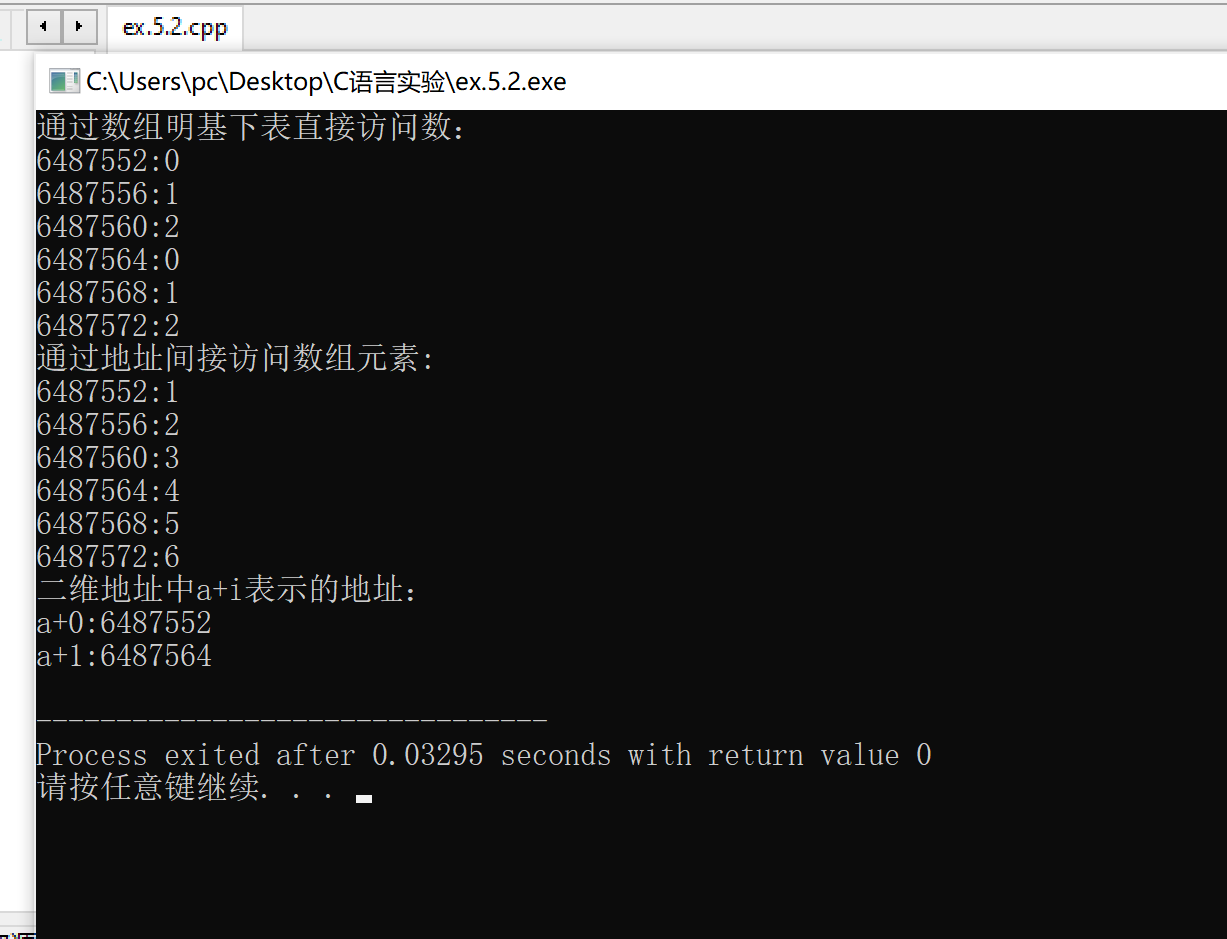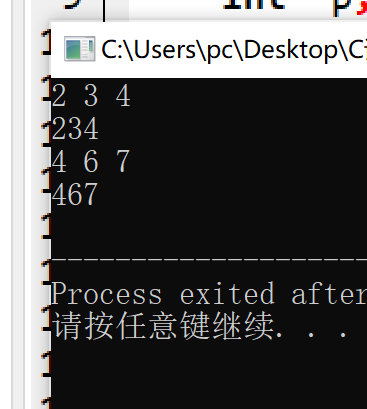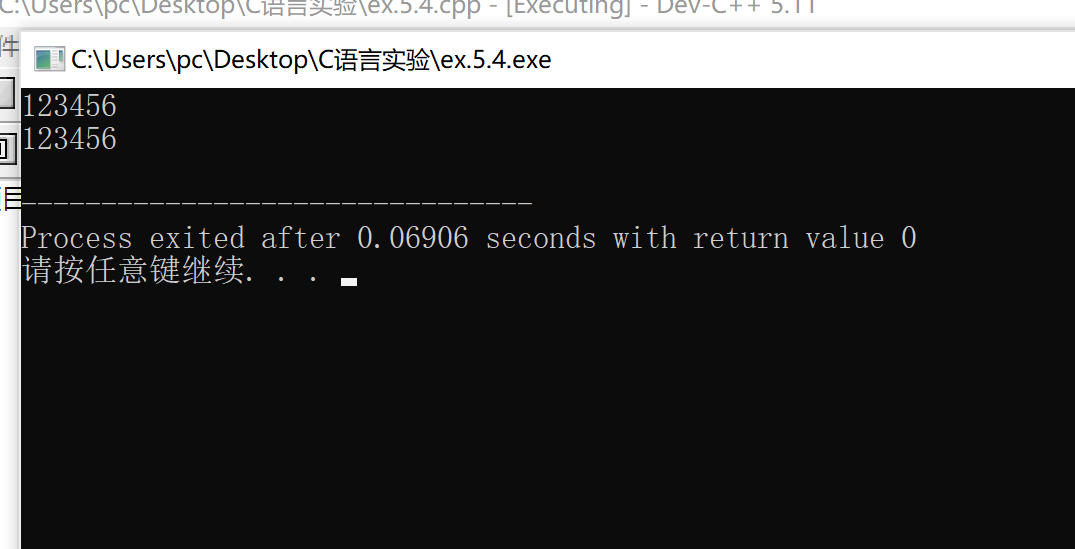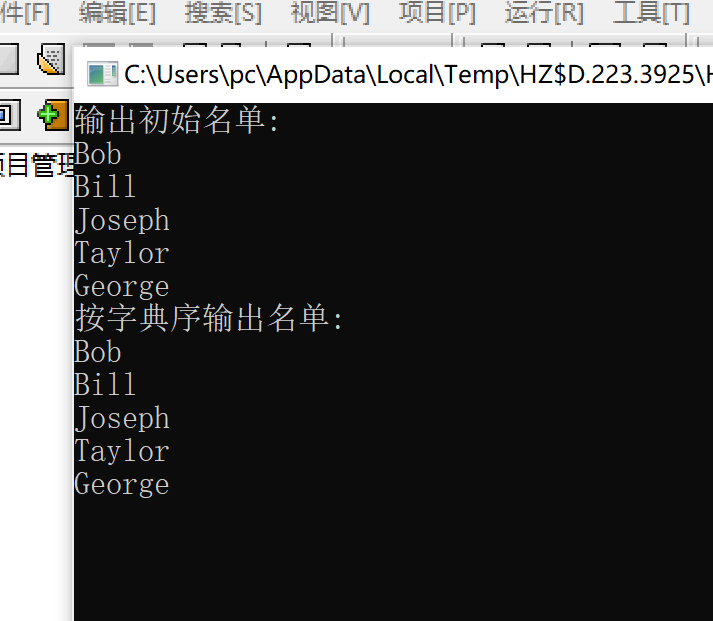实验五 数组和函数
实验任务1
#include<stdio.h>
const int N=3;
int main(){
int a[N]={1,2,3};
int i;
printf("通过数组名及下标直接访问数组元素:\n");
for(i=0;i<N;i++)
printf("%d:%d\n",&a[i],a[i]);
printf("通过地址间接访问数组元素:\n");
for(i=0;i<N;i++)
printf("%d:5d\n",a+i,*(a+i));
return 0;
}

问:1.数组元素在内存中是否是连续存放的? 答:是
2.对于数组元素及其地址的访问,以下访问方式是否是等价的? 答:是
实验任务2
#include<stdio.h>
const int LINE=2;
const int COL=3;
int main(){
int a[LINE][COL]={1,2,3,4,5,6};
int i,j;
printf("通过数组明基下表直接访问数:\n");
for(i=0;i<LINE;i++)
for(j=0;j<COL;j++)
printf("%d:%d\n",&a[i][j]);
printf("通过地址间接访问数组元素:\n");
for(i=0;i<LINE;i++)
for(j=0;j<COL;j++)
printf("%d:%d\n",a[i]+j,*(a[i]+j));
printf("二维地址中a+i表示的地址:\n");
for(i=0;i<LINE;i++)
printf("a+%d:%d\n",i,a+i);
return 0;
}

问:1.C语言中,二维数组在内存中是否是按行存放的? 答:是
2.对于二维数组元素及其地址的访问,以下方式是否是等价的? 答:是
3.对于二维数组a[2][3],以下方式是否是等价的? 答:是
实验任务3
// 使用指针变量间接访问一维数组
#include <stdio.h>
#include <stdlib.h>
const int N=3;
int main() {
int a[N];
int *p,i;
// 通过指针变量p,完成数组元素输入
for(p=a; p<a+N; p++)
scanf("%d", p);
// 过指针变量p,完成数组元素输出
for(p=a; p<a+N; p++)
printf("%d ", *p);
printf("\n");
p = a;
//通过指针变量p,完成数组元素输入
for(i=0; i<N; i++)
scanf("%d", p+i);
// 通过指针变量p,完成数组元素输出
for(i=0; i<N; i++)
printf("%d ", *(p+i));
printf("\n");
return 0;
}

问:1.程序中,指针变量p在使用时是否指向确定的地址? 答:不,根据输入值的不同,其指向也不同。
2.程序源码中,line12-line13执行完后,指针变量p指向哪里?line16-line17执行完后,指针变量p指向哪里? 答:指向a[N]
3.程序源码中,line22-line27执行完后,指针变量p指向哪里?line26-27执行完后,指针变量p指向哪里? 答:指向a所在的地址
//使用指针变量访问二维数组
#include<stdio.h>
int main(){
int a[2][3]={1,2,3,4,5,6};
int i,j;
int *p;
int (*q)[3];
for(p=a[0];p<a[0]+6;p++)
printf("%d",*p);
printf("\n");
for(q=a;q<a+2;q++)
for(j=0;j<3;j++)
printf("%d",*(*q+j));
printf("\n");
return 0;
}

问:1.程序源码中,line11改成如下形式是否可以? 答:可以
2.程序源码中,line18中,*q+j和*(*q+j)分别表示什么? 答:前者表示a[0]+j的值;后者表示a[0]+j的地址
3.???
4.A、F
实验任务5
1、
// 练习:使用二分查找,在一组有序元素中查找数据项
// 形参是数组,实参是数组名
#include <stdio.h>
const int N=5;
int binarySearch(int x[], int n, int item); // 函数声明
int main() {
int a[N]={2,7,19,45,66};
int i,index, key;
printf("数组a中的数据:\n");
for(i=0;i<N;i++)
printf("%d ",a[i]);
printf("\n");
printf("输入待查找的数据项: ");
scanf("%d", &key);
// 调用函数binarySearch()在数组a中查找指定数据项key,并返回查找结果给index
// 补足代码①
index=binarySearch(a,N,key);
if(index>=0)
printf("%d在数组中,下标为%d\n", key, index);
else
printf("%d不在数组中\n", key);
return 0;
}
//函数功能描述:
//使用二分查找算法在数组x中查找特定值item,数组x大小为n
// 如果找到,返回其下标
// 如果没找到,返回-1
int binarySearch(int x[], int n, int item) {
int low, high, mid;
low = 0;
high = n-1;
while(low <= high) {
mid = (low+high)/2;
if (x[mid]==item)
return mid;
else if(x[mid]>item)
high = mid - 1;
else
low = mid + 1;
}
return -1;
}

2、
// 练习:使用二分查找,在一组有序元素中查找数据项
// 形参是指针变量,实参是数组名
#include <stdio.h>
const int N=5;
int binarySearch(int *x, int n, int item); // 函数声明
int main() {
int a[N]={2,7,19,45,66};
int i,index, key;
printf("数组a中的数据:\n");
for(i=0;i<N;i++)
printf("%d ",a[i]);
printf("\n");
printf("输入待查找的数据项: ");
scanf("%d", &key);
// 调用函数binarySearch()在数组a中查找指定数据项key,并返回查找结果给index
// 补足代码①
index=binarySearch(a,N,key);
if(index>=0)
printf("%d在数组中,下标为%d\n", key, index);
else
printf("%d不在数组中\n", key);
return 0;
}
//函数功能描述:
//使用二分查找算法在从x中查找特定值item,数组x大小为n
// 如果找到,返回其下标
// 如果没找到,返回-1
int binarySearch(int *x, int n, int item) {
int low, high, mid;
low = 0;
high = n-1;
while(low <= high) {
mid = (low+high)/2;
if ( item == *(x+mid) )
return mid;
else if(item < *(x+mid))
high=mid-1;
else
low=mid+1;
}
return -1;
}

实验任务6
// 练习:使用选择法对字符串按字典序排序
#include <stdio.h>
const int N = 5;
void selectSort(char str[][20], int n ); // 函数声明,形参str是二维数组名
int main() {
char name[][20] = {"Bob", "Bill", "Joseph", "Taylor", "George"};
int i;
printf("输出初始名单:\n");
for(i=0; i<N; i++)
printf("%s\n", name[i]);
selectSort(name, N); // 调用选择法对name数组中的字符串排序
printf("按字典序输出名单:\n");
for(i=0; i<N; i++)
printf("%s\n", name[i]);
return 0;
}
// 函数定义
// 函数功能描述:使用选择法对二维数组str中的n个字符串按字典序排序
void selectSort(char str[][20], int n) {
int i,j,b,c,m;
char a[20];
for(i=0;i<=n;i++){
m=i;
for(j=i+1;j<n;j++){
for(b=0;b<20;b++){
if(str[m][b]<str[j][b])
break;
if(str[m][b]>str[j][b]){
m=j;
break;
}
}
}
}
if(m!=i){
for(c=0;c<20;c++){
a[c]=str[i][c];
str[i][c]=str[m][c];
str[m][c]=a[c];
}
}
}




